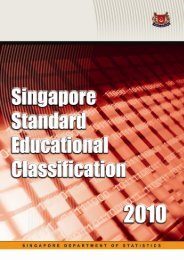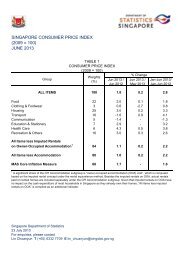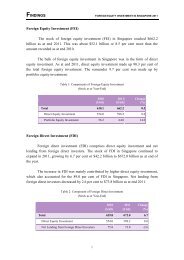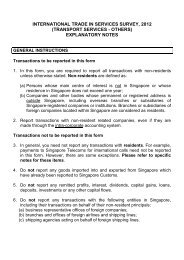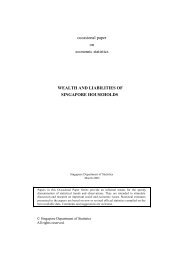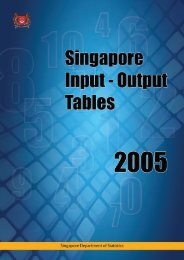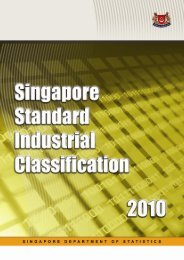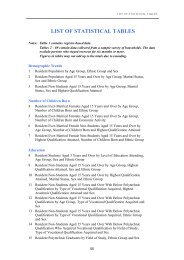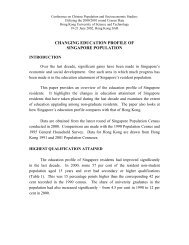Introduction - Statistics Singapore
Introduction - Statistics Singapore
Introduction - Statistics Singapore
Create successful ePaper yourself
Turn your PDF publications into a flip-book with our unique Google optimized e-Paper software.
INTRODUCTION<br />
INTRODUCTION<br />
The General Household Survey (GHS) is a large-scale national survey<br />
collecting information on the population and households in <strong>Singapore</strong>. The GHS is<br />
conducted in between the Population Censuses which are taken once in ten years,<br />
during the years ending in ‘0’. As a mini-Census, the GHS is the most comprehensive<br />
source of information on the profile of <strong>Singapore</strong>’s population and households.<br />
The GHS 2005 is the second in the series of mid-decade mini-censuses. The<br />
first GHS was conducted in 1995.<br />
Coverage<br />
Following from the Population Census 2000, the General Household Survey<br />
2005 adopted the de jure population concept. Under the de jure concept of “usual<br />
residence”, all <strong>Singapore</strong> residents (citizens and permanent residents) with valid local<br />
addresses were included in the total population count. Non-residents who stayed in<br />
<strong>Singapore</strong> were also included in the total population. The non-resident population<br />
comprised foreign workers, students and other foreigners who were not granted<br />
permanent residence in <strong>Singapore</strong>. The transient population such as tourists was<br />
excluded.<br />
Register-Based Approach and Sample Enumeration<br />
The GHS 2005 built upon the experiences of the Population Census 2000,<br />
combining a register-based approach with a large-scale sample survey. Under the<br />
register-based approach, key demographic data on the size, growth and structure of the<br />
population were obtained from the <strong>Singapore</strong> Department of <strong>Statistics</strong>’ Household<br />
Registration Database (HRD). The HRD captured basic individual information such as<br />
sex, age, ethnic group and type of house. Such information was updated by linking with<br />
existing government databases through unique identification numbers.<br />
xiii
INTRODUCTION<br />
Additional data items in the GHS 2005 were collected from a sample survey of<br />
8 per cent sample of dwellings. These included marital status and fertility, education<br />
and home language, economic characteristics, mode of transport, and overseas travel<br />
characteristics of the population, as well as housing and household characteristics.<br />
For the sample enumeration, the GHS 2005 adopted the tri-modal data<br />
collection strategy which was successfully implemented in Population Census 2000.<br />
This strategy comprised Internet Enumeration, Computer Assisted Telephone<br />
Interviewing (CATI) and face-to-face interviews. A key innovation in GHS 2005 was<br />
the use of Personal Digital Assistants (PDAs) in the face-to-face interviews. This was a<br />
first in <strong>Singapore</strong>’s history of household surveys.<br />
A total of 90,000 dwelling units throughout the whole island of <strong>Singapore</strong> was<br />
selected for GHS 2005. These dwelling units were divided into 15 batches which were<br />
spread over a period of 12-15 weeks. From the practical perspective, this helped to even<br />
out the load on resources for internet submission, CATI operations and fieldwork.<br />
Households in each batch had the option to submit their survey returns through the<br />
Internet or telephone interviews. Field interviewers visited the households only if they<br />
had not completed their survey returns via Internet or telephone interview after the<br />
appropriate due date.<br />
Data collected via Internet, CATI and PDAs were captured in the GHS 2005<br />
database without the need for data entry at the back-end. Coding of data on vocational<br />
qualification, occupation and industry was first carried out using a batch coding<br />
process. For records that could not be coded automatically, online coding was then<br />
carried out using a search function to facilitate the selection of the relevant codes. The<br />
final processing of the survey data involved the editing and verification of erroneous<br />
and inconsistent records.<br />
Upon completion of data processing, statistical tables were generated with the<br />
use of in-house tabulation templates and SAS software.<br />
xiv



